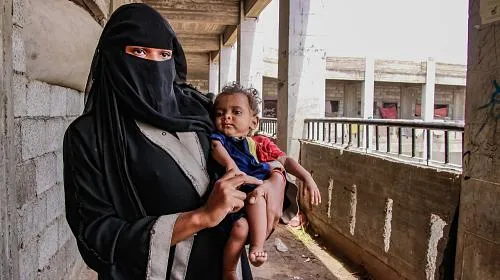SANAA (December 12, 2019) – A quarter of all civilian casualties across Yemen in 2019 were recorded in Hodeidah governorate. Despite a ceasefire in the port city being at the heart of last year’s Stockholm Agreement, Hodeidah has seen 799 civilian casualties since the Agreement was signed, the highest toll countrywide.
Families continue to flee for their lives with close to 390,000 Yemenis uprooted from their homes across the country so far in 2019. Half of all those displaced came from just three governorates – Hajjah, Hodeidah and Al Dhale’e.
Despite drops in the levels of violence compared to 2018, Hodeidah, Sa’ada, Taizz, Al Dhale, and Hajjah remain the most dangerous governorates for civilians in 2019.
As aid agencies working in Yemen, we are outraged that after almost five years, Yemenis continue to suffer from an incalculable humanitarian crisis fueled by conflict. Civilians continue to bear the brunt of the violence. Houses, farms, markets and health facilities are damaged and destroyed, worsening an already dire humanitarian situation.
Yemen is the world’s biggest humanitarian crisis. Ten million people face starvation and 7 million are malnourished. Fighting and restrictions put in place by the authorities are hampering our organizations from reaching the communities in greatest need. Conflict also continues to block people’s access to markets and services, and inflicts damage on essential infrastructure such as hospitals, schools, and water systems.
Last month’s signing of the Riyadh Agreement as well as a general de-escalation in hostilities presents a real window of opportunity to end the war. If urgent action is not taken we could see another five years of conflict, leading to a greater catastrophe for civilians.
We call on all conflict parties, the UN Security Council and countries with influence, to work together and speed up implementation of the Stockholm Agreement. The recent announcement on opening Sana’a airport for medical flights is a positive sign, and if actioned it will help thousands of sick Yemeni’s access lifesaving medical care.
Now is the time to build confidence towards peace through the Agreement and beyond, by implementing revenue-sharing from Hodeidah port to pay salaries across the country, and ending the politicized deadlock over fuel to resolve the crisis.
While we call for full implementation of the Stockholm Agreement, it should not be a pre-condition for peace in Yemen. A nationwide ceasefire must also be immediately put in place to secure long-overdue peace talks. What Yemen needs most is an end to the violence, through a political solution to the conflict that takes into account the needs of women, youth and all of civil society.
Signed by:
CARE
Action contre la Faim
Adventist Relief and Development Agency
Danish Refugee Council
Handicap International – Humanity and Inclusion
Islamic Relief
International Rescue Committee
Intersos
Medecins du Monde
Norwegian Refugee Council
Oxfam
Première Urgence Internationale.
Saferworld
Vision Hope International
ZOA
Latest casualty (deaths and injuries) and humanitarian figures:
- A total of 1,008 civilians were killed by armed violence so far this year, down from 2,049 for the whole of last year.
- More civilians were killed or injured by ground fighting this year than in the 12 months before.
- Over 2,100 incidents of armed violence impacted civilians since the Stockholm Agreement – no improvement on the 12 months prior.
- Increased number of civilians were killed or injured by explosive ordnance, from 349 people impacted last year to 504 so far this year.
- 327 incidents of armed violence directly impacted civilian houses in 2019, 60 per cent of the total incidents. Half the child and women casualties in 2019 resulted from incidents impacting houses.
- Over 40 per cent of all incidents of armed violence impacting civilians occurred in Hodeidah Governorate. A quarter of all 3,086 country-wide civilian casualties took place in Hodeidah, followed by Taiz Governorate.
- The overall number of civilian casualties dropped compared with 2018, largely owing to a significant reduction in airstrikes in Hodeidah, and a recent de-escalation of violence across the country.
- Data and analysis on civilian casualties and impact on civilian infrastructure was conducted by ACAPS and CIMP. This is open source data and has not been separately verified by the INGOs that are signatories here.
About CARE’s work in Yemen:
CARE reaches 1.5 million Yemenis every month, across twelve governorates of Yemen. We provide lifesaving food, cash, water and sanitation services to those in need. As well as our emergency interventions, we work to ensure people have sustainable incomes and community structures like schools, wells and roads; we empower women and young people economically by developing their skills and enabling them to start their own businesses; and we work in reproductive health, ensuring safer childbirth through training midwives and rehabilitating maternity health facilities. CARE has worked in Yemen since 1992. You can find out more about our work here.
About CARE:
Founded in 1945, CARE is a leading humanitarian organization fighting global poverty and providing lifesaving assistance in emergencies. CARE has more than seven decades of experience helping people prepare for disasters, providing lifesaving assistance when a crisis hits, and helping communities recover after the emergency has passed. CARE places special focus on women and children, who are often disproportionately affected by disasters. To learn more, visit www.care.org.
Media Contacts:
Vanessa Parra, vanessa.parra@care.org, +1 917-525-0590 (NYC)
Mahmoud Shabeeb, mshabeeb@care.org, +962 79 146 39 03 (Amman, Jordan)

